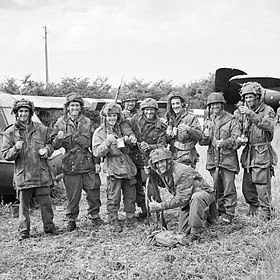Operation Needle Stack
This article is incomplete because it is pending further input from participants, or it is a work-in-progress by one author. Please comment on this article's talk page to share your input, comments and questions. Note: To contribute to this article, you may need to seek help from the author(s) of this page. |
| Operation Needle Stack | |||||||
|---|---|---|---|---|---|---|---|
| Part of the Asianna and the Pacific Campaign of the Second Europan War | |||||||
 Troops of the 6th Airborne Division in Hamcheon after securing the town. | |||||||
| |||||||
| Belligerents | |||||||
|
| |||||||
| Commanders and leaders | |||||||
| Units involved | |||||||
|
|
| ||||||
Operation Needle Stack (15 November - 29 November 1944) was a major airborne operation that took place in Joyonghea during the Third Joyonghean-Quenminese War. It was considered to be the operation that gave the Allies a dagger thrust towards the Quenminese lines. Vital objectives include securing key bridges at Anseong, Hamcheon, Tamseon and Eensyeong to provide a way for the XXX Eastern Corps to push through and take the city of Kangjon.
The operation had two phases, Needle which was the initial airborne drops behind enemy lines. Stack which was the attempt of the Third Rubrumian Army to engage the western flank and to reach the city of Eensyeong by means of the city of Tongjon, just 15 kms west of Tamseon. The timely arrival of the Rubrumian-Jutlandish forces at Tongjon enabled the XXX Eastern Corps to push through Tamseon without the worry of enemy reinforcements intercepting the column. By the 25 September, elements of the Lucis 11th Army linked-up with the airborne forces at Eensyeong, completing the primary objective. An Imperial counterattack to retake Eensyeong ensued on 27 September but the offensive was bogged down with the arrival of the Rubrumian-Jutlandish forces, causing the Imperial forces to call off the attack.
The operation became a major success for the Allies as it split the Imperial forces in Joyonghea into two sectors. The eastern sector continued to hold out until February while the western sector continued the war until July 1945.